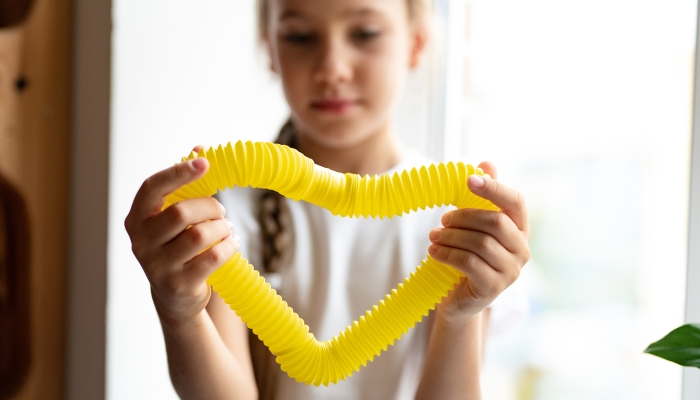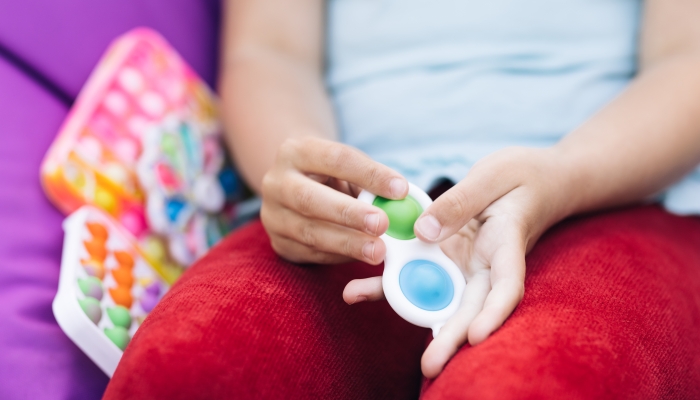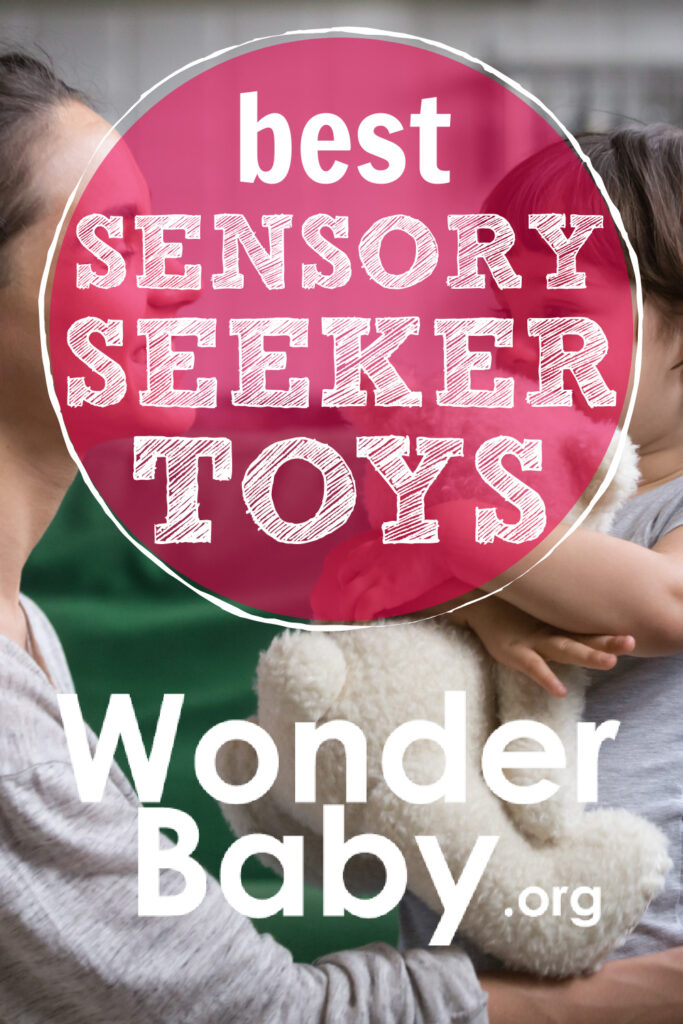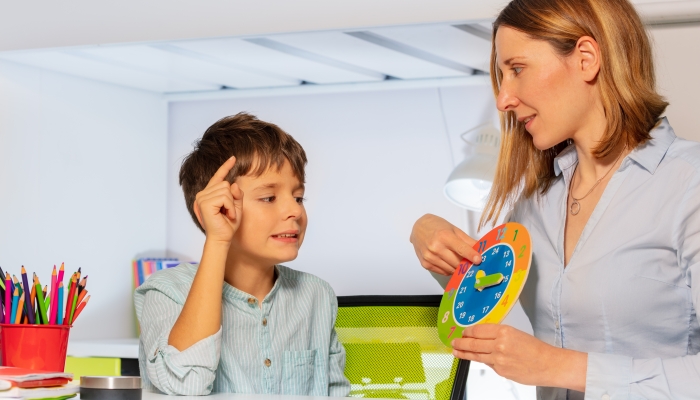5 Best Sensory Seeker Toys

This post may contain affiliate links; please see our terms of use for details.
- Children who are sensory seekers look for sensory input through physical movement, tactile activities, or creating loud sounds.
- Sensory seeker toys engage a child’s preferred senses and help them to self-regulate, focus, and stay calm.
- Sensory seeker toys give kids an appropriate, enjoyable, and safe way to manage sensory input needs.
Children with autism, sensory processing disorder, ADHD, and other neurodiverse needs may engage in sensory-seeking behavior that helps them process the world around them.
Sensory seekers may rock, spin, hang upside down, or enjoy roughhousing. They may ask for tight hugs or prefer tight-fitting clothing. They may chew on their sleeves or other objects. Or they might like to make loud sounds.
Sensory-seeking behavior may be more pronounced in situations that kids find stressful, like being in a crowded place. Sensory toys provide kids with the tactile input, sensations, and materials they need to deal with challenging situations or feelings or just to help them calm down and focus.
Take a look at our guide to the best sensory seeker toys, what to look for, and how to choose them for your child.
Chewigem Chew Necklace: Best for Kids Who Like to Chew
Children soothed by chewing often end up chewing on sleeves, clothes, pencils, or anything they happen to have in their hands. This can be messy, unsafe, and even embarrassing, especially for older kids.
This cool Chewigem Dog Tag Chew Necklace is a discreet and stylish alternative. Made of non-toxic silicone, it comes in a huge variety of designs, textures, and styles. It’s tough, safe, and specifically designed for wearing and chewing.
No products found.
Chewigem offers a big selection of bangles and toys for younger kids, teens, and adults. Always follow the manufacturer guidelines for age and use to avoid choking hazards with any kind of “chewelry.”
Tangle Jr. Classic: Best for Hand Fidgeting
- It is the ultimate creativity tool for kids and adults alike
- It has hard, smooth texture and bright solid color sections
- Its improves fine motor skills and useful for hand & wrist therapy
- A great way to keep hands busy and the brain focused
Tangle Jr. Classic is small, portable, and discrete for kids who fidget with their hands. Users appreciate that it’s not as noisy as fidget cubes or as distracting as a fidget spinner, and it’s good at keeping hands busy and minds focused.
The Tangle has a smooth hard surface and morphs into different shapes. Returning it to its original coil shape is also satisfying. It’s great for fidgeting and for developing motor skills and hand dexterity.
Tangle makes toys in different colors and textures so that your child can fidget with their favorite colors, designs, or metallics. They even make Furry Fidgets to add extra sensory input for kids who like fuzzy sensations too.
- ✅PLUSH FIDGET TOYS: The Tangle Furry Fidget combines two of the most popular ways of play. Fidget and Plush! The Furry Tangle includes a real Tangle Jr on the inside and is wrapped with a soft layer of high quality plush to make a whole new sensory experience!
- ✅FURRY TANGLES: Experience the original Tangle Jr with a brand new twist! The Furry Tangle has all the same sensory stimulation as an original Tangle Jr, but now with a satisfying layer of plush!
- ✅PLUSH TANGLE FIDGET TOY: The Furry Tangle is the original Plush Tangle! This series of Furry Tangles is part of the limited Furry Series X-1. Get it while supplies last!
- ✅PUT DOWN THE ELECTRONICS: If you’re trying to get your child away from a tablet or phone, this twist fidget toy is a great non-disruptive solution to your gadget problem. These tangle fidget sensory toys are great for everyone ages 3 to 85. These fidget therapy tangle packs are perfect gifts for birthdays or as party favors. This tangle Jr fidget toy is also wonderful incentive and prize for kids.
There are many imitations on the market. Make sure you’re buying a well-made, sturdy toy that won’t break easily. These are for ages three and up.
Fat Brain Toys Teeter Popper: Best for Rocking and Spinning
If your child likes to rock, roll, tilt, and balance, their sensory-seeking behavior is about stimulating the vestibular system which is our sense of spatial awareness. The Fat Brain Toys Teeter Popper is a fabulous sensory toy for kids who like to move.
- A THRILLINGLY UNIQUE INSTRUMENT FOR PLAY; a concave board covered with sturdy silicone suction cups
- ROCK, ROLL, SIT, STAND – endless ways to play; suction cups POP as the Teeter Popper Rocks!
- PERFECT FOR AGES 3 YEARS AND UP; exceptionally strong, sturdy plastic; handles on ends for stability
- IMPROVES CORE STRENGTH AND STABILITY, balance, coordination, gross motor skills; engages imagination
Your child can sit or stand on it to rock and challenge their balance and build their core strength. They can also sit in it to spin.
The Teeter Popper has strong suction cups on the bottom of the rocker which make a fun popping sound that sensory-seeking kids love. The suction adds resistance, helping your child develop balance, strength, and gross motor skills.
It’s for ages three and up and can hold up to 110 pounds, so your child can play with this for a while.
Art3D Sensory Floor Tiles: Best Multi-Sensory Toy
- Come in 6 tiles with different color: red, blue, purple-pink, red-blue, orange-red, green-yellow
- Safety: Filled by cosmetic liquid, environmental protection and safety, non-toxic for children
- Interactive: The colored liquid is highly responsive to the pressure from tapping or stepping
- Anti slip function:backside with pvc anti slip mat,strong anti slip function, protect floor and keep still
For a multi-sensory experience the whole family can interact with and enjoy, check out these Art3D Sensory Floor Tiles for tactile input and visual stimulation.
Your child just has to push on a liquid-filled tile with fingers, hands, feet, or even their whole body to watch the colors shift and change for a calming experience.
Kids love the squishy feeling of the liquid. Plus, these tiles are also super sturdy, so they can withstand jumping or multiple kids playing together.
The liquid is safe and non-toxic. Anti-slip backing for the tiles also means they won’t slip from under your child’s feet when they play, stand, or dance on them.
If your child likes to chew, a liquid-filled toy like this isn’t recommended, but it’s safe for children ages three and up.
Theo The Sensory Companion Dog: Best Toy for Comfort and Calming
- ESSENTIAL GIFT FOR COMFORT OR PLAY! Theo with his 18-inch-long body makes the perfect gift for kids, teens, adults, birthdays, holidays, or just because!
- SOOTHING & COMFORTING: Weighting 2.5 lbs, this lovable and cuddly scented animal plush friend gives comforting hugs. Theo’s soft, durable floppy body can lay across your lap or shoulders and even sits-up.
- HOT & COLD PACK: The hook and loop pocket in his tummy holds a hot/cold pack of ceramic beads that emits a gentle French Lavender aroma. Remove pack to heat in the microwave, or chill in the fridge, then replace for soothing temperatures anyone can love!
- FRIENDLY COMPANION: Ideal for kids ages 3 and up. Great for carrying along during the day to appointments, over-night visitations, bedtime, or any unfamiliar environment. And he’s the perfect lapdog for older adults who are in need a soft companion.
Theo The Sensory Companion Dog by Roylco is cute and cuddly, but he’s no ordinary stuffed animal. Theo’s floppy, soft body weighs 2.5 pounds and is the perfect size for laying on a lap or across your child’s shoulders.
Weighted toys like Theo are soothing for sensory-seeking children who may search for opportunities for firm pressure. Theo’s plush fur is soft and comforting. He also has a pocket in his tummy that holds a pack of lavender-scented ceramic beads which you can make hot or cold, for an extra soothing and calming sensation.
Take Theo to appointments, and unfamiliar places, or have him around at bedtime. He’s safe for children ages three and up.
What Is Sensory Seeking?

Children with sensory processing disorder, autism, ADHD, or other diagnoses may have challenges managing sensory input or have other sensory needs.
This means that taking in information from their senses—sight, sound, taste, smell, touch—can affect them differently than it does neurotypical children. Generally, sensory processing issues tend to fall into two categories: sensory seeking and sensory avoiding11. Morin, A.. Sensory seeking and sensory avoiding: What you need to know. Understood. https://www.understood.org/en/articles/sensory-seeking-and-sensory-avoiding-what-you-need-to-know.
Sensory-seeking kids tend to underreact to sensory information, so they look for objects or activities that give them more input. For example, sensory-seeking kids might like tight hugs or clothing or they might spin, rock, or be very physically active.
Sensory-avoiding kids tend to overreact to sensory information and find sensory input overwhelming. For example, a sensory-avoidant child might like headphones to block out environmental noise or they may prefer not to be touched by people.
For kids with sensory sensitivities, sensory toys can be useful tools for helping them to self-regulate, calm down, relax, focus, concentrate, and behave in socially appropriate ways by giving them a healthy and safe outlet for managing their sensory needs.
How Do Sensory Toys Help Kids With Sensory Issues?

Sensory toys and sensory play are beneficial for all children22. Palumbo, J. “Jay”. The Power Of Sensory Play In Childhood Development. Forbes. 2023. https://www.forbes.com/sites/jenniferpalumbo/2023/10/10/the-power-of-sensory-play-in-childhood-development/?sh=46fee54d4faa , regardless of whether they have sensory input issues. Engaging the senses through play is important for cognitive development.
Rich sensory environments help children create neural pathways for their future learning. According to Autism Speaks33. Esposito, A.. What are sensory toys and how do they help? Autism Speaks. 2023. https://www.autismspeaks.org/blog/what-sensory-toys , sensory toys benefit children who are sensory seekers or who have sensory processing issues by “helping them engage with their senses, provide feedback to their sensory systems, and regulate their sensory needs.“
By catering to a specific or preferred sensory need, sensory toys can help redirect a child’s focus to their other senses, help them calm down, and reduce their anxiety, allowing them to engage with family members or peers.
They can also reduce a child’s fear or frustration around a particular kind of sensory input, reducing their stress around sensory processing. For example, they can help parents and children avoid or manage sensory meltdown in unfamiliar public places.
How To Choose Sensory-Seeking Toys

Every child’s sensory-seeking needs are different. Many toys are marketed as “sensory.” However, they won’t all be appropriate for every child, so it’s important to consider your child’s specific needs.
Here are a few things to consider when choosing sensory-seeking toys:
| Safety |
|
| Your child’s age |
|
| Your child’s sensory needs |
|
References
- Morin, A. (n.d.). Sensory seeking and sensory avoiding: What you need to know. Understood. https://www.understood.org/en/articles/sensory-seeking-and-sensory-avoiding-what-you-need-to-know
- Palumbo, J. “Jay.” (2023, October 10). The Power Of Sensory Play In Childhood Development. Forbes. https://www.forbes.com/sites/jenniferpalumbo/2023/10/10/the-power-of-sensory-play-in-childhood-development/?sh=46fee54d4faa
- Esposito, A. (n.d.). What are sensory toys and how do they help? Autism Speaks. https://www.autismspeaks.org/blog/what-sensory-toys

Related Posts

Autism
Developing Time Management Skills in Children with Autism: 7 Tips
Learn how you can use structure and visual aids to help your child with autism learn time management skills.

Autism
Occupational Therapy for Children with Autism: How It Can Make a Difference
Children with autism face challenges in many different areas. Occupational therapy can help children address these difficulties while having fun!

Sensory Activities
5 Sand Play Activities to Encourage Fine Motor Development
Sensory bin, at the beach, or in a sandpit? Try these sand play activities to help toddlers and preschoolers develop their fine motor skills.




